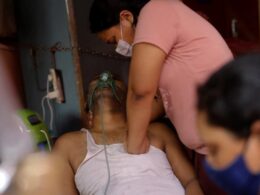Levels of public expenditure on mental health are low (a global median of 2.1% of government health expenditure) and particularly meagre in low-and middle-income countries.
Global estimates of people receiving care for specific mental health conditions (used as a proxy for mental health care as a whole) remained less than 50%,
WHO — World Health Organization
Mental Health and Substance Use
Dévora Kestel
Director, Department of Mental Health and Substance Use
WHO 8 October 2021
Key Messages (Edited by the author of the blog)
- The World Health Organization’s new Mental Health Atlas paints a disappointing picture of a worldwide failure to provide people with the mental health services they need, at a time when the COVID-19 pandemic is highlighting a growing need for mental health support.
- Levels of public expenditure on mental health are low (a global median of 2.1% of government health expenditure) and particularly meagre in low- and middle-income countries
Global estimates of people receiving care for specific mental health conditions (used as a proxy for mental health care as a whole) remained less than 50%,
- with a global median of 40% of people with depression and
- just 29% of people with psychosis receiving care.
None of the targets for effective leadership and governance for mental health, provision of mental health services in community-based settings, mental health promotion and prevention, and strengthening of information systems, were close to being achieved.
- In 2020, just 51% of WHO’s 194 Member States reported that their mental health policy or plan was in line with international and regional human rights instruments, way short of the 80% target.
- And only 52% of countries met the target relating to mental health promotion and prevention programmes, also well below the 80% target.
- The only 2020 target met was a reduction in the rate of suicide by 10%, but even then, only 35 countries said they had a stand-alone prevention strategy, policy or plan.
Key Findings:
171 of WHO’s 194 Member States (88%) at least partially completed the Mental Health Atlas 2020 questionnaire; the submission rate exceeded 73% in all WHO regions.
Performance dimensions:
- INFORMATION SYSTEMS AND RESEARCH FOR MENTAL HEALTH
- MENTAL HEALTH SYSTEM GOVERNANCE
- FINANCIAL AND HUMAN RESOURCES
- SERVICE AVAILABILITY AND UPTAKE
- MENTAL HEALTH PROMOTION AND PREVENTION
INFORMATION SYSTEMS AND RESEARCH FOR MENTAL HEALTH
- 31% of WHO Member States regularly compile mental health-specific data covering at least the public sector in their country.
In addition, 40% of Member States reported the compilation of mental health data as part of general health statistics only. - The percentage of countries reporting no mental health data compiled in the last two years has declined from 19% of responding countries in 2014 to 15% of responding countries in 2020.
- 76% of Member States were able to report on a set of five selected indicators that covered mental health policy, mental health law, promotion and prevention programmes, service availability and the mental health workforce.
This is an increase from 60% of Member States in 2014. - 64 646 articles on mental health were published in 2019. The global percentage of research output on mental health relative to total research output was 4.6% in 2019.
31% of WHO Member States regularly compile mental health-specific data covering at least the public sector in their country.
MENTAL HEALTH SYSTEM GOVERNANCE
- 75% of Member States have a stand-alone policy or plan for mental health, which is an increase from 68% in 2014.
57% of Member States have a stand-alone mental health law, which is an increase from 51% in 2014. - 46% of WHO Member States have updated their mental health policy or plan and 27% have updated their mental health law since 2017.
- 99 countries, equivalent to 67% of responding countries, or 51% of WHO Member States, reported full alignment of their policy or plan for mental health with international and regional human rights instruments.
- 74 countries, equivalent to 64% of responding countries, or 39% of WHO Member States, reported full alignment of their law for mental health with international and regional human rights instruments.
- Human and financial resources allocated for the implementation of policies/plans are limited.
In addition, only 19% of WHO Member States reported that indicators were available and used to monitor implementation of a majority of the components of their policies/plans. - 45% of WHO Member States reported that a dedicated authority or independent body undertakes inspections of mental health services and responds to complaints about human rights violations.
- 21% of WHO Member States have a mental health policy or plan that is in the process of implementation and is fully compliant with human rights instruments.
- 28% of WHO Member States have a mental health law that is in the process of implementation and fully compliant with human rights instruments.
- 76% of responding countries have ongoing formal collaboration with at least one stakeholder group. Levels of collaboration with service users and family/caregiver advocacy groups are low (35% of responding countries)
75% of Member States have a stand-alone policy or plan for mental health, which is an increase from 68% in 2014.
Human and financial resources allocated for the implementation of policies/plans are limited.
FINANCIAL AND HUMAN RESOURCES
- Levels of public expenditure on mental health are low (a global median of 2.1% of government health expenditure) and particularly meagre in low- and middle-income countries.
- 80% of responding countries reported that care and treatment of persons with severe mental health conditions are included in national health insurance or reimbursement schemes and in insurance coverage for inpatient/outpatient mental health services.
- Globally, the median number of mental health workers is 13 per 100 000 population. There continues to be extreme variation between World Bank income groups (from below two workers per 100 000 population in low-income countries to over 60 in high-income countries).
Levels of public expenditure on mental health are low (a global median of 2.1% of government health expenditure) and particularly meagre in low- and middle-income countries.
Globally, the median number of mental health workers is 13 per 100 000 population. There continues to be extreme variation between World Bank income groups — from below 2 to 60 workers per 100 000 population …
SERVICE AVAILABILITY AND UPTAKE
- Only 49 countries, equivalent to 31% of responding countries, or 25% of WHO Member States, reported the integration of mental health into primary health care.
This was estimated based on the adoption of guidelines for integration into primary care, the provision of pharmacological interventions, psychosocial interventions and training for mental health conditions at primary care level, and the involvement of mental health specialists in training and supervision of primary care professionals. - The median number of mental hospital beds per 100 000 population ranges from below two in low-income countries to over 25 in high-income countries.
Globally, the median number of mental hospital beds reported per 100 000 population increased from 6.5 beds in 2014 to 11 beds in 2020,
while the median admission rate per 100 000 population increased from 36 admissions in 2014 to 72 admissions in 2020. - Outpatient visits per 100 000 population ranged from 100 visits in low-income countries to over 5000 visits in high-income countries. Globally, the median rate of reported visits increased from 2014 to 2020, along with the median number of outpatient facilities.
- Globally, the median number of child and adolescent inpatient facilities is less than 0.5 per 100 000 population and less than two outpatient facilities per 100 000 population.
- 112 countries reported that, on average, 0.64 community-based mental health facilities exist per 100 000 population.
There is extreme variation between income groups, with 0.11 facilities per 100 000 population in low-income countries and 5.1 facilities per 100 000 population in high-income countries. - The service utilization rate for persons with psychosis per 100 000 population was 212.4, with considerable variation between high- and low-income countries.
- Service coverage for psychosis was estimated at 29% using 12-month service utilization data data collected for the Mental Health Atlas 2020. Service coverage for depression was estimated at 40% using the World Mental Health Surveys.
Only 49 countries, equivalent to 31% of responding countries, or 25% of WHO Member States, reported the integration of mental health into primary health care.
The median number of mental hospital beds per 100 000 population ranges from below 2 to 25 .
Service coverage for depression was estimated at 40% using the World Mental Health Surveys.
MENTAL HEALTH PROMOTION AND PREVENTION
- 101 countries, equivalent to 68% of those countries that responded, or 52% of WHO Member States, have at least two functioning national, multisectoral mental health promotion and prevention programmes. This is an increase from 41% of Member States in 2014.
- Of 420 reported functioning programmes,
– 18% were aimed at improving mental health awareness or combating stigma,
– 17% were school-based mental health prevention and promotion programmes and
– 15% were aimed at suicide prevention. - 54 countries, corresponding to 39% of responding countries, or 28% of WHO Member States, reported programmes for mental health and psychosocial support integrated as a component of disaster preparedness and/or disaster risk reduction.
- The global age-standardized suicide rate in 2019 was estimated to be 9.0 per 100 000 population. This represents a 10% reduction in the rate of suicide since the 2013 baseline of 10 per 100 000 population.
The global age-standardized suicide rate in 2019 was estimated to be 9.0 per 100 000 population.This represents a 10% reduction in the rate of suicide since the 2013 baseline of 10 per 100 000 population.
Executive Summary
The Mental Health Atlas project was initiated by the World Health Organization (WHO) to map mental health resources globally and to provide an up-to-date overview of mental health system profiles in different countries and regions. It aims to provide up-to-date information on the existence of mental health services and resources around the world, including mental health policies, legislation and financing, the availability and utilization of mental health services, human resources and information/data collection systems. The first assessment under the project was carried out in 2001, to construct global and regional databases, maps and profiles. A number of updates have been published subsequently.
The 2020 version of the Mental Health Atlas tracks progress in implementing WHO’s Comprehensive Mental Health Action Plan 2013–2020. The 2014 edition of the Mental Health Atlas provided baseline values for the Action Plan’s targets, while the 2017 version provided interim values for these targets. This 2020 edition of the Mental Health Atlas is based on 2019 data and enables monitoring of progress made towards meeting these targets by 2030. Additionally, it provides baseline values for the agreed and updated indicators and targets contained in the newly extended Comprehensive Mental Health Action Plan 2013–2030; further editions of the Mental Health Atlas will enable monitoring of progress towards meeting these targets by 2030.
The WHO Mental Health Atlas project is conducted in close collaboration with WHO’s six Regional Offices and with WHO Country Offices worldwide. Information was obtained via a questionnaire sent to designated mental health focal points within the Ministries of Health in each WHO Member State. The key findings are presented in the box on pages 3–4.
Baseline, interim and progress values reported in 2014, 2017 and 2020 respectively are given in the table on page 5 for each of the six Comprehensive Mental Health Action Plan targets. Progress values for 2020 indicate that the targets committed to by WHO Member States have not been achieved. Also, the rates of progress for all targets (except suicide rate) between 2014, 2017 and 2020 were not satisfactory. Progress values for 2020 indicate that the global targets can be reached in 2030 only if there is a collective global commitment over the next 10 years across Member States to make massive investments and expanded efforts at the country level relating to mental health policies, laws, programmes and services.
Despite steady progress seen in the adoption of policies, plans and laws, as well as improvements in capacity to report regularly across years on a set of core mental health indicators, the Mental Health Atlas 2020 shows massive inequalities in the availability of mental health resources and their allocation between high- and low-income countries and across regions.
It also shows significant gaps globally between the existence of policies, plans and laws and the implementation and monitoring of these and the allocation of resources.
Similar gaps can be seen in the implementation of mental health services at the primary health care level.
- While guidelines for the integration of mental health into primary health care exist and have been adopted in most countries, with activities ongoing for training and supervision, the integration of interventions for service delivery, such as pharmacological and psychosocial interventions for mental health conditions, remains limited.
- The Mental Health Atlas 2020 also shows significant limitations in the capacity of countries’ mental health information systems to report on specific indicators such as service utilization.
A significant limitation to this edition of the Mental Health Atlas was that data were collected from countries during the global COVID-19 pandemic, which affected the quality and quantity of the data collected.
The second round of the national pulse survey on continuity of essential health services during the COVID-19 pandemic, conducted between January and March 2021, identified mental, neurological and substance (MNS) use disorders as being the programmes most disrupted (45% of responding countries).
Moreover, the list of countries responding to various data points within each question was sometimes different from those of previous years, which limits comparisons with previous editions of the Mental Health Atlas.
Finally, it is important to acknowledge the limitations of self-reported data, which are often reported by a single focal point.
Comprehensive Mental Health Action Plan 2013–2020: baseline and progress values for global targets and objectives

PROJECT TEAM AND PARTNERS
The Mental Health Atlas is a project of the World Health Organization (WHO). The overall vision and conceptualization of the project is provided by Dévora Kestel. The Mental Health Atlas 2020 is the latest in a series of publications that first appeared in 2001, with subsequent updates published in 2005, 2011, 2014 and 2017. This edition of the Mental Health Atlas is supervised and coordinated by Tarun Dua and Fahmy Hanna.
In WHO Member States, key project collaborators were the mental health focal points in ministries of health, who provided information and responses to the Atlas survey questionnaire. A full list of collaborators is provided as Appendix A of this report.
Mental Health Atlas team members from WHO Regional Offices, who contributed to the planning and collation of data and liaised with focal points in Member States, were: Florence Baingana (WHO Regional Office for Africa); Renato Oliveira E Souza, Maria del Carmen Martínez Viciana, Claudina Cayetano, Matías Irarrázaval (WHO Regional Office for the Americas); Khalid Saeed, Wafaa Elsawy (WHO Regional Office for the Eastern Mediterranean); Dan Chisholm, Ledia Lazeri, Elena Shevkun (WHO Regional Office for European Region); Nazneen Anwar, Manju Rani, Chencho Dorji (WHO Regional Office for South-East Asia); and Martin Vandendyck, Mary Joanne Biquera, Jennifer Hall, Yutaro Setoya (WHO Regional Office for the Western Pacific). The contribution and support of colleagues from WHO Country Offices is also gratefully acknowledged.
At WHO Headquarters, a team of staff members and consultants comprising Tarun Dua, Fahmy Hanna, Jorge Castro, Marieke van Regteren Altena, Lamia Jouini, Maya Bachet and Jose Angel Garcia provided central technical and administrative support to the project, including development of the questionnaire and an associated completion guide, management of the online data collection system, validation of information and responses and liaison with Member States and WHO Regional Offices, as well as analysis of data and preparation of this report. They received inputs, advice and support from the following WHO colleagues: Vanessa Cavallera, Dan Chisholm, Neerja Chowdhary, Nathalie Drew, Alexandra Fleischmann, Michelle Funk, Grazia Motturi, Shekhar Saxena, Alison Schafer, Katrin Seeher, Chiara Servili, Mark van Ommeren and Inka Weissbecker.
Sincere thanks are also due to the following experts for their significant technical inputs and review of the Atlas 2020 questionnaire and/or draft report: Corrado Barbui, Vanessa Cavallera, Fatma Charfi, Fiona Charlson, Gururaj Gopal, Kara Jaeschke, Dzmitry Krupchanka, Antonio Lora, Crick Lund, Zahiri Josefina Malik, Aiysha Malik, María Elena Medina-Mora, Maria Grazia Motturi, Pratap Sharan, Yuet Wa Diana Suzuki, Graham Thornicroft, Alessandra Trianni and Daniel Vigo.
The contribution of each of these team members and partners, which has been crucial to the success of this project, is very warmly acknowledged. IT support and advice for the online data collection platform was provided by Marcel Minke. Editing of this report was carried out by David Wilson.
PREFACE
I am pleased to present the the Mental Health Atlas 2020. Two decades ago, in 2000, the World Health Organization launched Project Atlas to address a gap in mental health information. The objectives of this project included the collection, compilation and dissemination of relevant information about mental health resources across all countries. The first set of publications from the project were Atlas: Mental Health Resources in the World, 2001 and Atlas: Country Profiles on Mental Health Resources in the World, 2001. Several updates have been published subsequently. The WHO Mental Health Atlas has become the best-known and most comprehensive resource for information on mental health resources globally.
The 2020 version of the Mental Health Atlas tracks progress in implementing WHO’s Comprehensive Mental Health Action Plan 2013–2030. The 2014 edition of the Mental Health Atlas provided baseline values or the Action Plan’s targets for 2013, while the 2017 version provided interim values for its targets for 2016. During the Seventy-fourth World Health Assembly in May 2021, delegates endorsed the Comprehensive Mental Health Action Plan 2013–2030, including the plan’s updated implementation options and indicators and targets. This 2020 edition is based on 2019 data and enables the monitoring of progress made towards meeting these targets by 2020. Specifically, the Mental Health Atlas 2020 provides baseline values for the agreed and updated indicators and targets of the newly extended Comprehensive Mental Health Action Plan 2013–2030; further editions of the Atlas will enable the monitoring of progress towards meeting these targets by 2030. The WHO Mental Health Atlas team is grateful to all Member States who submitted their data for the 2020 edition of the Atlas during the challenging times of the COVID-19 pandemic.
We see the Mental Health Atlas as an ongoing activity of WHO, one where more accurate information will become available as the concepts and definitions of resources become more refined and data sources become more organized and reliable. Overall, we hope that the Mental Health Atlas 2020 will assist health planners and policy-makers within countries and regions to identify areas that need urgent attention.
Dévora Kestel
Director, Department of Mental Health and Substance Use, WHO
Names cited:
Mental Health Atlas team members from WHO Regional Offices, who contributed to the planning and collation of data and liaised with focal points in Member States, were: Florence Baingana (WHO Regional Office for Africa); Renato Oliveira E Souza, Maria del Carmen Martínez Viciana, Claudina Cayetano, Matías Irarrázaval (WHO Regional Office for the Americas); Khalid Saeed, Wafaa Elsawy (WHO Regional Office for the Eastern Mediterranean); Dan Chisholm, Ledia Lazeri, Elena Shevkun (WHO Regional Office for European Region); Nazneen Anwar, Manju Rani, Chencho Dorji (WHO Regional Office for South-East Asia); and Martin Vandendyck, Mary Joanne Biquera, Jennifer Hall, Yutaro Setoya (WHO Regional Office for the Western Pacific). The contribution and support of colleagues from WHO Country Offices is also gratefully acknowledged.
At WHO Headquarters, a team of staff members and consultants comprising Tarun Dua, Fahmy Hanna, Jorge Castro, Marieke van Regteren Altena, Lamia Jouini, Maya Bachet and Jose Angel Garcia provided central technical and administrative support to the project, including development of the questionnaire and an associated completion guide, management of the online data collection system, validation of information and responses and liaison with Member States and WHO Regional Offices, as well as analysis of data and preparation of this report. They received inputs, advice and support from the following WHO colleagues: Vanessa Cavallera, Dan Chisholm, Neerja Chowdhary, Nathalie Drew, Alexandra Fleischmann, Michelle Funk, Grazia Motturi, Shekhar Saxena, Alison Schafer, Katrin Seeher, Chiara Servili, Mark van Ommeren and Inka Weissbecker.
Originally published at:
Mental Health ATLAS 2020
The Mental Health Atlas, released every three years, is a compilation of data provided by countries around the world on…www.who.int












